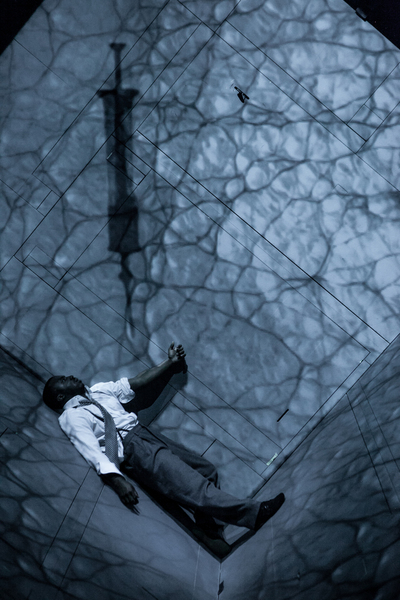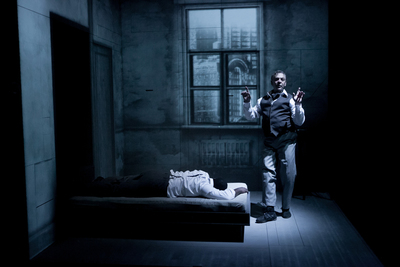Needles & Opium
by Celina Colby
Marc Labrèche stands suspended in the air 20 feet above Emerson’s Cutler Majestic stage. His face is illuminated from below casting an ominous shadow across his brow. A background of cosmic dust frames him. The mournful croons of Miles Davis’s trumpet echo through the theater. Labrèche opens his mouth and with a thick French accent transforms into the famous French poet Jean Cocteau: “New York is a city that never sits down and thinks. A city that never lays down and dreams.”
So sets the scene for the groundbreaking production of Needles and Opium, the brainchild of playwright and director Robert Lepage. Originally performed in the ‘90s, the production has been completely re-imagined for its contemporary revival. The hypnotic performance follows three intertwined story lines. In 1949 Miles Davis traveled to Paris where he met and fell in love with Juliette Greco. At the same time Jean Cocteau traveled to New York for the first time. The romantic and creative destruction that resulted from both trips sends Cocteau and Davis into spiraling drug addictions. Connecting the two stories in the present day is a lonely Québécois in Paris to narrate a documentary on Davis.
Perhaps the most innovative change in the new production is the stage setting. Lepage is known for his elaborate sets but Needles and Opium take his eccentricities to new heights—literally. The entire show is performed on a three-walled, rotating cube suspended in the air above the stage. Secret doors open and close from within the walls, allowing the actors to enter and exit from all sides of the unique set. Projected images set the scene on the cube, transitioning it seamlessly from a sparse hotel room to a grungy Parisian street and then to a Life magazine photo shoot. Suspended by invisible wires, Labrèche as Cocteau floats above and through the set as a kind of transcendent narrator and critique of American life and creativity. Robertson flies too, until his crippling drug addiction takes him down to the floor where he slides along the rotating cube in a somehow both elegant and tragic manner.
Though the show was originally staged as a one-man production, Lepage has added a second cast member for the revival. Wellesley Robertson III plays Davis, a silent, soulful character skulking in alleys with his trumpet and assembling his heroin needles as expertly as his instrument. Labrèche doubles as the contemporary voice actor and Jean Cocteau. Labrèche’s performance was extraordinary. Known for his comedic work as Canada’s answer to Jon Stewart, the actor shows his immense range by expertly adapting to this serious dual role. He slides from one character to the other with the grace of an acrobat, adopting at once the critical, intellectual nature of Cocteau and the defeated, mourning attitude of the heartbroken voice actor. While Labrèche does all the talking in the play, Robertson’s performance is no less striking. A trained acrobat, Robertson glides along the rotating stage as though it were second nature to him. His smooth movements show an immense range of emotion in a very minimal gesture.
At the beginning of the performance, Labrèche says there are three things a needle cannot fix: anguish, low self-esteem and heartbreak. These three qualities make this piece and the work of the artists represented so extraordinary. The themes of heartbreak and addiction are most clearly represented. At the beginning we see Robertson assembling his trumpet at a small table in front of the stage. The image of his hands putting together the parts is projected on the cube. After his love affair with Greco, Robertson assumes the same position, this time to assemble his needles. Cocteau narrates Davis’s high, speaking about opium’s ability to “remove you from the train that speeds towards death.” After a phone conversation with his old lover, the voice actor seeks a similar reprieve from his emotions at a hypnotist. Integrated in the storyline of love and loss is how they relate to the creative process. Both Davis and Cocteau created monumental artistic works out of their emotional strife, in spite of their addictions. It begs the question, is an addictive personality required of great artists? Perhaps the great depth of feeling that creates profound works of art is also what causes the artists’ downfall.
The uniting tie between the three storylines is a grounding display of humanity. Cocteau paints an image for us of New York as a city that is racing towards death, never stopping to think or feel. Though Davis and Cocteau might use opium and heroin to escape this fate, they can’t avoid the inevitable outcome. With such a limited time to live, is it not better to feel something, even if it’s pain?
Despite the heavy themes of the performance, there are some humorous moments. Labrèche as the voice actor has substantial trouble getting an operator to place an international call and later spends half the night inventing creative ways to muffle the sounds of intercourse coming from the hotel room next door. These everyday struggles, and the use of the humanizing voice actor, bring the content down to a relatable level. We’ve all been there, at the end of a relationship, at the end of a difficult customer service call, at the end of our wits with a comic frustration. And ultimately, whether you’re Miles Davis, Jean Cocteau or just an average Joe, the feelings of anguish, low self-esteem and heartbreak, and the way we recover from them, are what makes us human.
Needles and Opium is playing at the Cutler Majestic Theatre through April 12.
________________________________________________________________________________________________
Image Credit: Images courtesy of ArtsEmerson, photos credit: Nicola Frank-vachon..
________________________________________________________________________________________________
Celina Colby is the editorial assistant at Art New England magazine and the blogger behind Trends and Tolstoy.



